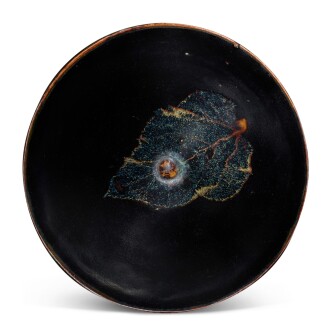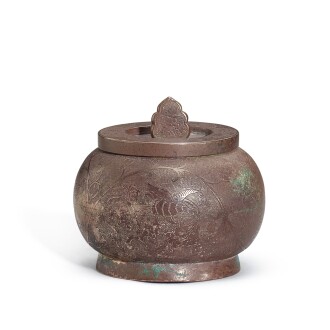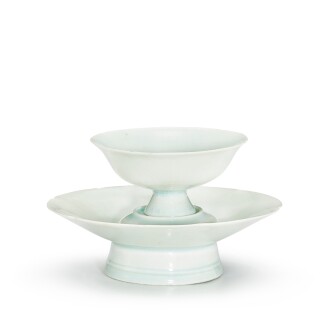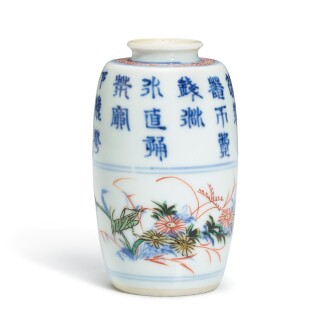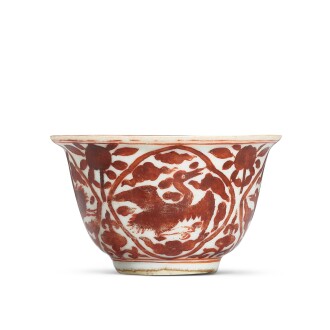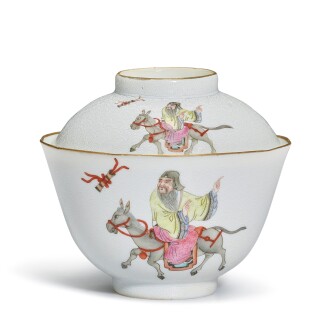Echoes of Fragrance
Echoes of Fragrance presents the evolution of tea culture from the Tang to the Qing dynasties. This special tea-themed online sale of Chinese art is a companion to Sotheby’s inaugural auction of rare and premium Puerh.
We observe the development of tea consumption through the teawares and drinking vessels of each period, prompted by changes in preparation methods. These occurred in three major shifts in history: compressed tea cakes were decocted during the Tang dynasty (618–907), fine ground tea powder was whisked during the Song dynasty (960–1279), and whole tea leaves were steeped during Ming dynasty (1368–1644), a style that continued onwards into the Qing dynasty (1636–1912) and to the present day.
蘇富比首場以茶為主題的網上專場「甘茗廻香–中國歷代茶器的演變」,展現唐至清朝歷代飲茶文化演變,拍賣由12月8起至16日;同期尚有蘇富比首場普洱茶專場「珍茶淺酌」,涵蓋清末民初至今明星茶品,皆彌足珍貴。
中國人的飲茶文化源遠流長,如今大家熟悉的泡茶方式起源於明朝,並與明太祖朱元璋的開國政策息息相關。在明代之前,豐盛富饒的茶文化盛行於唐宋,彼時達官貴人流行「鬥茶」,飲茶方式與今人殊異,堪值細味。此外,五花八門的茶具亦反映出歷朝飲茶方式的演變。
- Cake
- 茶餅
- Powder
- 茶粉
- Leaf
- 茶葉
-
 Tang Dynasty: Cooked TeaWhile tea enjoys an important place in the culture of China, the drinking styles and customs were quite different thousands of years ago. The practice finds its origins as an herbal decoction and then later evolved into something resembling a thick soup. It was during the Tang dynasty that tea would be accorded its cultural significance. Lu Yu’s masterpiece ‘The Classic of Tea’ captured the imagination of the literati, creating a sea change by associating tea with philosophy and Buddhist thought.
Tang Dynasty: Cooked TeaWhile tea enjoys an important place in the culture of China, the drinking styles and customs were quite different thousands of years ago. The practice finds its origins as an herbal decoction and then later evolved into something resembling a thick soup. It was during the Tang dynasty that tea would be accorded its cultural significance. Lu Yu’s masterpiece ‘The Classic of Tea’ captured the imagination of the literati, creating a sea change by associating tea with philosophy and Buddhist thought.
Image: A Palace Concert, Tang Dynasty, ©Collection of the National Palace Museum, Taipei -
 唐朝:煮茶唐朝人的煮茶方式頗為講究,過程類近煎藥,故亦稱為「煎茶」 。唐代茶藝專家陸羽的《茶經》詳細記載了當時的煮茶方式,簡略而言是將烘乾的茶餅研磨碾碎成粉末,再煮成茶湯,並在沸水裡下鹽調味;煮茶階段亦有講究,共三沸,確保水滑茶濃,並形成茶沫即「湯花」。《茶經》細述飲茶的不同環節,將飲茶提升為一種精神享受,自成一方意境和美學。
唐朝:煮茶唐朝人的煮茶方式頗為講究,過程類近煎藥,故亦稱為「煎茶」 。唐代茶藝專家陸羽的《茶經》詳細記載了當時的煮茶方式,簡略而言是將烘乾的茶餅研磨碾碎成粉末,再煮成茶湯,並在沸水裡下鹽調味;煮茶階段亦有講究,共三沸,確保水滑茶濃,並形成茶沫即「湯花」。《茶經》細述飲茶的不同環節,將飲茶提升為一種精神享受,自成一方意境和美學。
圖片:唐代《宮樂圖》 ©台北故宮博物院藏 -
 Song Dynasty: Whisked TeaTea appreciation reached its zenith during the Song dynasty; its association with ceremonies and literary gatherings elevated the status of tea in the culture. This period saw the development of whisked tea. The tea leaves would be processed into compressed cakes, and then later broken and ground into a fine powder. Boiled water would be poured over the powder in the bowl and whisked into a thick froth.
Song Dynasty: Whisked TeaTea appreciation reached its zenith during the Song dynasty; its association with ceremonies and literary gatherings elevated the status of tea in the culture. This period saw the development of whisked tea. The tea leaves would be processed into compressed cakes, and then later broken and ground into a fine powder. Boiled water would be poured over the powder in the bowl and whisked into a thick froth.
Image: Preparing Tea (detail), attributed to Liu Sung-nien, Song Dynasty, ©Collection of the National Palace Museum, Taipei -
 宋朝:點茶宋人繼承豐盛的唐朝文化,對飲茶的講究程度不遑多讓,甚至更加精緻。宋人同樣將茶餅研磨成末,但投茶方式不同。宋人先將茶粉與少量沸水調和成膏狀,然後一邊添水,一邊用茶筅擊拂出泡沫,日本抹茶製法便是源於此。湯色越乳白、 「湯花」越勻細久聚、色香味俱佳者為勝,這就是宋人的「鬥茶」。除此之外,當時人甚至會玩「分茶」,又稱為「茶百戲」,即是利用茶沫湯花形成幻變的圖像,猶如現代的咖啡拉花一樣。
宋朝:點茶宋人繼承豐盛的唐朝文化,對飲茶的講究程度不遑多讓,甚至更加精緻。宋人同樣將茶餅研磨成末,但投茶方式不同。宋人先將茶粉與少量沸水調和成膏狀,然後一邊添水,一邊用茶筅擊拂出泡沫,日本抹茶製法便是源於此。湯色越乳白、 「湯花」越勻細久聚、色香味俱佳者為勝,這就是宋人的「鬥茶」。除此之外,當時人甚至會玩「分茶」,又稱為「茶百戲」,即是利用茶沫湯花形成幻變的圖像,猶如現代的咖啡拉花一樣。
圖片:宋代 劉松年《攆茶圖》局部 ©台北故宮博物院藏 -
 Ming & Qing Dynasties: Steeped TeaIn an act of political reform, the Hongwu Emperor of the Ming dynasty banned compressed teacakes. This decree would create a dramatic changeover of tea culture. Putting an end to the elaborate processes and rituals surrounding tea, the emperor favoured a simple brewing method of pure whole-leaf infusions (i.e., the way in which we typically consume tea today). Tea drinking flourished onwards through the Qing dynasty, and the new style of preparation spurred on the design of new vessels. The customs and preparation of modern day tea most resemble those of this era.
Ming & Qing Dynasties: Steeped TeaIn an act of political reform, the Hongwu Emperor of the Ming dynasty banned compressed teacakes. This decree would create a dramatic changeover of tea culture. Putting an end to the elaborate processes and rituals surrounding tea, the emperor favoured a simple brewing method of pure whole-leaf infusions (i.e., the way in which we typically consume tea today). Tea drinking flourished onwards through the Qing dynasty, and the new style of preparation spurred on the design of new vessels. The customs and preparation of modern day tea most resemble those of this era. -
 明清時期:泡茶明代以前,權貴階級只飲茶餅,視散茶為末流,甚至窮工極巧,追求茶餅壓花,極致如龍鳳團茶。明代開國皇帝朱元璋痛惡奢逸之風,下詔廢止製造龍團,納貢只採散茶,此舉一下子改變了唐代以來的飲茶文化。自此,飲茶方式以簡易繁,泡茶文化漸始在上流社會和民間盛行,茶具亦逐漸演變成現代人熟悉的模樣。彼時,繁瑣奢靡的「鬥茶」之風已止,取而代之的是清飲。疏影明窗、爐香裊裊、三兩知己、或琴棋書畫為伴,細抿清茶,在浮生中暫求半日之閒。
明清時期:泡茶明代以前,權貴階級只飲茶餅,視散茶為末流,甚至窮工極巧,追求茶餅壓花,極致如龍鳳團茶。明代開國皇帝朱元璋痛惡奢逸之風,下詔廢止製造龍團,納貢只採散茶,此舉一下子改變了唐代以來的飲茶文化。自此,飲茶方式以簡易繁,泡茶文化漸始在上流社會和民間盛行,茶具亦逐漸演變成現代人熟悉的模樣。彼時,繁瑣奢靡的「鬥茶」之風已止,取而代之的是清飲。疏影明窗、爐香裊裊、三兩知己、或琴棋書畫為伴,細抿清茶,在浮生中暫求半日之閒。

Featured Highlights 精選拍品

Literary references to drinking tea trace as far back as before the Han dynasty (202-220). However, it wasn’t until the Tang dynasty that it changed from a rare luxury to widespread custom in China, thanks to the ascendant influence of Buddhism, which generally discouraged the use of intoxicants. In 750, Lu Yu completed the Classic of Tea (Cha Jing), which was the first text devoted to the appreciation of tea, including a comprehensive history, cultivation techniques, preparation methods, and drinking styles. Tea proved to be crucial for the expansion and prosperity of the empire, because its widespread consumption created demand that extended beyond the borders of the country. Production of this valuable commodity transformed formerly barren areas into flourishing plantations in the southern regions of China. This was a development that would prove to be an important source of revenue for the imperial government, especially after it enacted key fiscal reforms that imposed taxes on tea. The taste for tea would spread outward to neighbouring empires or tribes, and with this growing demand, the Tang administrations would barter tea for horses necessary for military trade.
漢代以前已有關於飲茶的文獻紀錄,但飲茶文化真正蔚然成風的時代還是在唐朝開始。公元750年,陸羽完成《茶經》,詳細記述飲茶源流、種茶方式、煮茶技巧、品飲步驟等。唐朝文化廣披四海,唐人飲茶風氣從中原蔓延至邊陲異域,甚至外邦亦開始要求向唐朝換取茶葉。隨著國內外對茶葉需求攀升,茶葉價格不菲,唐朝政府開始專營茶葉,以往被視為山林瘴氣之地的中國南方開始大規模種茶,政府亦開始與西南及西北少數民族以茶馬互市,各取所需。此外,唐代佛教大興,飲茶文化自中唐起亦進入禪林,形成「茶禪」文化,日本茶道精神亦起源於此。

Tea braziers were one of the key vessels in tea preparation in the Tang dynasty, when tea cakes were first ground into powder form and boiled in a brazier for consumption. The late Tang dynasty painting Gong Le Tu in the National Palace Museum, Taipei, depicts a classic scene of court ladies and musicians in a tea ceremony, where elaborate tea braziers were presented on the table.
茶爐茶釜為唐代煮茶必備用具之一。唐代流行「吃茶」文化,煮茶前先將茶餅壓成粉末,再放入茶釜中烹煮。台北故宮博物院藏晚唐時期的《宮樂圖》描繪了宮中仕女煎茶品茗的情境,其中一仕女手拿長柄茶勺,將茶湯自茶釜分進各人茶盌內。
Fresh tea leaves were first steamed, then ground in a special mortar, later compressed into cakes and then allowed to dry by stringing them up with reed or bamboo. When it came time to brew the tea, the cake would be broken into small chunks, then ground, sifted, and boiled.
唐代時期盛行蒸青團茶,茶青採集後經過蒸青、壓製、烘焙等七道工序而成為餅狀。煮茶前需先將餅茶炙烤,再碾成細末,方可煎茶。
Tea spoons were originally used as utensils to measure and transfer powdered-form tea from the brazier to a bowl. Eventually, the tea spoon would be gradually replaced with a whisk. Cai Xiang’s The Record of Tea (Cha Lu) recorded that ‘Tea spoon must be heavy, such that it gives enough force when tea is whisked.'
茶匙原用於量取茶末或分盛茶湯。點茶文化初期,茶匙又演變增加了擊拂茶湯的功能。蔡襄《茶錄·器論·茶匙》載:「茶匙要重,擊拂有力。」
Tea bowl on lobed stand is a classic form produced in the Xing kilns during the latter part of the Tang dynasty, where its shape drew inspiration from gold and silver wares of the period.
花口盞及托為晚唐時期邢窰典型造型,其形可追溯至同期的金銀器。

Tea reached its zenith during the Song dynasty in terms of popularity and sophistication. Access to tea had become so widespread that it was no longer a luxury for just members of the nobility or elite scholars. Yet its association with ceremonies (such as weddings), competitions, and literary gatherings, along with the fact that Song dynasty emperors were famously fond of tea, elevated its cultural status and connoisseurship. Tea would be sent to emperors as imperial tribute. The Song dynasty would see the further elaboration in the production of compressed tea cakes, achieved through painstaking labour-intensive processes. Notable in this period was the development of whisked tea. Similar to earlier preparations, compressed tea cakes would be ground into a fine powder. Where it differed from the Tang dynasty method was rather than cooking the pulverized tea, boiled water would be poured over the powder in the bowl and whisked into a thick froth.
Banner Image: Eighteen Scholars of the Tang (detail), attributed to Emperor Huizong, Song Dynasty, ©Collection of the National Palace Museum, Taipei
宋代的品茶文化極為精緻,可謂登峰造極,而且飲茶之風盛行,無論貴族雅士還是平民百姓皆喜飲茶甚至鬥茶。賞茶品茗也是慶典、婚禮和文人雅聚的重要環節,連宋朝皇帝也喜愛品茶,更加大幅提升了茶的社會地位,讓賞茶文化發展蓬勃。在宋朝,茶葉是貢品,茶餅的製作工藝比前朝更加繁複,耗工費時,每個步驟一絲不苟,而聞名的點茶法也是發展於宋代。點茶法,是先將茶餅壓碎後磨成細末,置於茶盌之內,再逐漸注入沸水,加以擊拂成細滑如乳的泡沫,與唐朝人將茶葉加入水中烹煮的方法迥然有別。
圖片:《十八學士圖》(局部),(傳)宋徽宗繪 ©台北故宮博物院藏
Those familiar with chanoyu, the Japanese ceremonial preparation and service of green tea, may note its similarity with Song dynasty tea rituals. It was around this time that Japanese Buddhist monks may have introduced this way of tea from China. As a result, an array of Song dynasty teawares had been exported into Japan.
宋人繼承唐朝輝煌文化,在細節上更精緻繁複。自唐朝起,日本僧人學者紛紛來華,茶文化遂隨使者東傳到日本。日本茶道源自唐宋的煎茶與點茶法,其方式仍保留唐宋古韻。宋瓷精巧秀麗,而隨使者返國的唐物茶具被奉若珍寶,留下不少佳話。
A Seismic Shift 物轉星移
The Ming dynasty would usher in great changes, creating a break with long-held conventions, not only with tea as an imperial tribute, but also the way it would be consumed. The Hongwu Emperor, founder of the dynasty, banned compressed tea cakes in an act of political reform that would have a seismic impact on tea culture in China. The Hongwu Emperor eschewed the resource-intensive production and elaborate rituals of tea practiced in earlier periods, and instead preferred the common custom of steeping leaves – pouring boiling water directly into the loose leaves in a vessel. The Emperor's decree paved the way to innovations in new teawares, such as the teapot.
到了明朝,飲茶的方式起了翻天覆地的變化。明朝開國皇帝朱元璋改革朝政,同時禁止製作茶餅,徹底改變了唐宋以來中國的茶文化。朱元璋摒棄前朝費工耗時的製茶方式及品茶儀式,改用直接簡單的方法泡茶,將茶葉放進茶具當中, 再直接沸水倒入,新型茶具如茶壺和紫砂壺就是始於明朝。

明太祖像©台北故宮博物院藏

Following the Hongwu Emperor's decree banning the production of compressed teacakes, his son Zhu Quan, the Prince of Ning, wrote the Tea Manual (Cha Pu) in 1440, a treatise on preparation, teawares, and appreciation of tea. The Tea Manual is a seminal work that is generally considered to have kicked off a new era in China’s tea culture.
洪武帝朱元璋禁團茶,其子寧王朱權於正統四年(1440年)著《茶譜》,講述製茶、品茶之道以及茶具的鑑賞,開啟了中國茶文化的新篇章。

Image: Spring Dawn in the Han Palace (detail), Sun Hu, Zhou Kun and Ding Guanpeng, Qing Dynasty, ©Collection of the National Palace Museum, Taipei
圖片:孫祜、周鯤、丁觀鵬《院本漢宮春曉圖卷》局部 ©台北故宮博物院藏







